
Getting an estimate for your technological project:
A collaborative client-supplier process
As a client
“How much is it going to cost me?”
This has to be the number one question heard by service providers. It’s also the question your boss and colleagues ask you when you talk about this new technological project that could benefit your team or the enterprise. First things first, you request a quote from your provider. But is this estimate representative of the total cost of the project? Can you include it as-is in your annual budget? Some experts will claim that their quote does indeed represent the final amount to be spent on your project. But you might have unpleasant surprises along the way. Because a quote is – first and foremost – an approximate estimate, and not an exact representation of the total costs of your project.
Whether you’re planning the redesign of your website, the development of a new mobile application or the launch of a revolutionary software, the following advice will help you better prepare to ask and get a realistic quote for your IT project.
An estimate is…
An estimate is an approximate evaluation of the costs and deadlines involved in the delivery of a specific project, from the first to the last stage, based on the variables presented by the customer to the service provider.
It is an idea of a budget, a reference point for the continuation of the project.
An estimate is not…
An estimate is not a fixed contract, nor is it a final commitment to deliver the project according to the stated budget. Rather, it is an estimate of the project’s costs, and doesn’t represent a fixed amount to be paid for your project to be delivered
What is the proportion of estimates that correspond to the real costs of a project?
Your project exceeded the costs announced in the initial quote?
Don’t worry, you are not the only one facing this situation.
The Cone of Uncertainty Theory, presented in our previous article, reveals that estimates are rarely accurate, especially when they are produced in the initial stages of the client-supplier collaboration. The Chaos Report points out that barely 16% of all technology projects are delivered on time and within the budget initially planned. A shocking statistic to take into account when you’re establishing a budget for your next IT project. There are, however, concrete courses of action that will allow you to detail your project as much as possible. This will reduce the uncertainty factor and facilitate the calculation of the costs to be considered, in order to reduce the variability between the initial estimate and the final amount to be spent on the project.
Before requesting an estimate, ask yourself the right questions
You must complete a reflection exercise before asking for a quote. To do this, ask yourself the following questions:
- What are the issues and risks related to my project?
- Who should be involved in this project and in discussions with the supplier?
- Do I have all the information relevant to the accurate evaluation of this project?
- What integrations are necessary to carry out this project?
- What technology tools and softwares do we currently use?
- What are my concerns related to the completion of this IT project?
- In the case of an unforeseen issue, what kind of flexibility do I have in terms of the budget, deadlines and resources needed to complete this project?
Some suppliers, including Logient, offer workshops to support you in this reflection process.
Top tips for getting a realistic estimate
In order to help your supplier in delivering a quote that is as realistic as possible, make sure you take on the following steps to reduce uncertainty to a minimum:
- Break your project down into smaller components and try to detail them as much as possible, highlighting the issues and risks associated with each phase. You might even be able to split your project into multiple, smaller projects. This could help, as your supplier might be able to provide a quote for each of these smaller projects can probably be more clearly envisioned.
- Invest part of your budget upstream to make your supplier’s job easier. This preparation can take many forms, including building a detailed specification document, designing mock-ups for the new website to be produced, carrying out preliminary analyses, etc. We generally recommend dedicating 10% of your total budget to this stage.
- Actively participate in the process of building the quote. Ask as many questions as possible and share all project-relevant information with your supplier. This will give you a better understanding of the final estimate’s true value.
- Request an estimate from multiple vendors. Make sure that each resource involved in defining the estimate has the information and experience necessary to produce a realistic quote.
- Take as much time as needed. A properly prepared quote will not be delivered to you within 24 hours of the first meeting with your supplier. Consider the estimate as an ongoing process in which all risks, issues and assumptions related to the project are pinpointed to maximize your chances of success.
- Carry out a proof of concept in collaboration with your supplier. In order to further reduce uncertainty, you might want to dedicate part of your budget upstream to conduct a proof of concept before getting started on the actual, bigger project. This investment in time and resources, which can be as minimal as a work effort over 2 days, will help your supplier better understand your business challenges and technological environment, so the estimate is aligned with your reality and as realistic as possible.
What questions should I ask my supplier?
- What are the uncertainties and risks your team foresees?
- What is the contingency plan for each of the risks associated with the project?
- How much should I put aside for contingencies not included in the initial estimate?
- What is the proportion of my budget allocated to managing risk and uncertainty?
- When can I expect to receive the quote?
The key to a good estimate : a great client-supplier collaboration
It is by working together with your supplier that you can facilitate the estimation process, so you get an estimate that is as realistic as possible.
Make sure you prepare ahead of time to request an estimate, and that you have all relevant details on hand. After all, you are the one who serves as a guide for the supplier’s technical and professional teams, who depend on your availability and the information you share with them to have a clear understanding of your project’s costs, challenges and duration.
More often than not, spending a few extra hours on the process of producing an estimate will help you avoid many surprises during the project.
Take the time to participate fully in the process – you will certainly benefit from it later on.
Since producing a quote is a team effort, suppliers should also be prepared to participate in the process. Check out our second article to better understand their methods and reality.



















